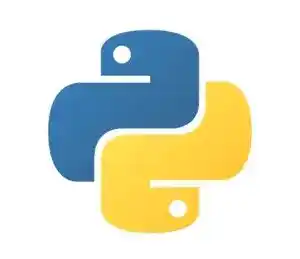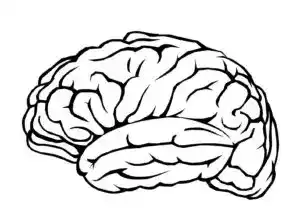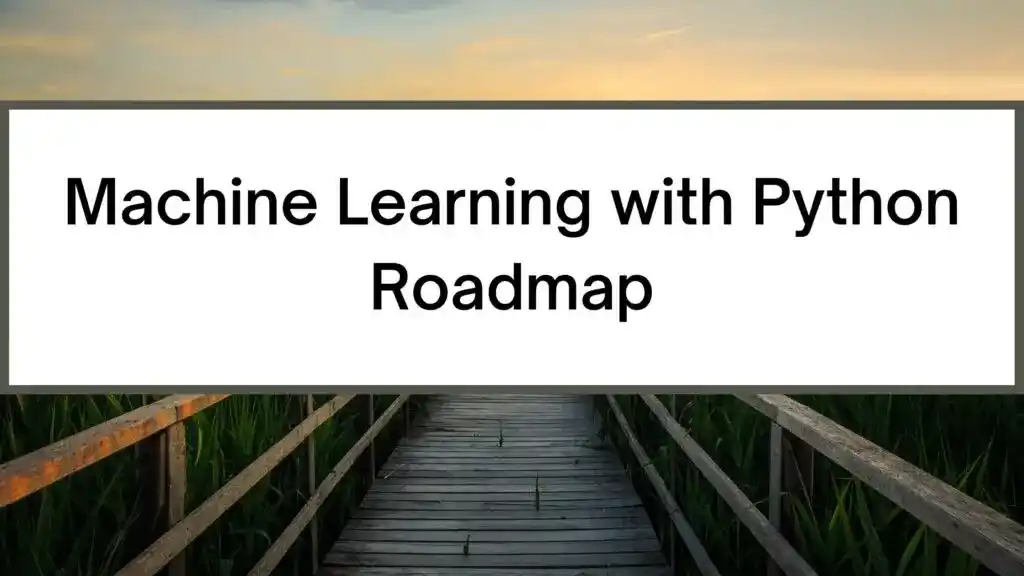As a beginner in Machine Learning, people have questions like, “Where do I start?” or “What should I learn first?“. So, if you have these questions in your mind, stay with me till the end of this article. I will discuss 8 Basic Steps to Learn Machine Learning with Python.
Note- This article is focused on Python. You can use another programming language, but these steps are for Python.
If you want to learn Machine Learning, don’t rush. Take your time and follow these 8 Basic Steps to Learn Machine Learning with Python. You can bookmark this article so that you can refer to it as you go.
So, without further ado, let’s get started-
Basic Steps to Learn Machine Learning with Python
Note- These steps are my own experimented steps. I followed these steps when I was learning ML.
Step 1- Learn Python First

If you are a complete beginner and don’t have knowledge of Python Programming, then start with learning Python. But if you already have Python knowledge, then you are one step closer to Machine Learning.
I started my Machine Learning journey with Python.
Why?
Because Machine Learning is all about implementation. And if you don’t have programming knowledge, you can’t implement anything.
At this step, only learn Python Basics, so that you can code in Python. As a beginner in python, you can refer to any Free Python Tutorial available online. I have already written an article for Best Free+Paid Resources to learn Python Online. You can refer to this article.
For your convenience, I am again mentioning some best resources to learn Python-
Resources for Learning Python-
- Introduction to Python Programming (Udacity Free Course)
- The Python Tutorial (PYTHON.ORG)– This Python Tutorial is official Python documentation. This tutorial will provide you so many Python basic concepts.
- Python Tutorial- MLTUT– This is a small contribution from my side. I tried to make this tutorial easy to understand. This is not a very advanced level tutorial, but yes, you will get a basic knowledge of Python.
- Python for Everybody (Coursera)– This specialization program will teach you fundamental programming concepts including data structures, networked application program interfaces, and databases, using the Python programming language.
- Python for Absolute Beginners! (Udemy)– It’s a good free online course with 2.5 hours of content.
- Python 3 Tutorial (SOLOLEARN)– This is another great tutorial to learn Python. This tutorial will clear your basic concepts of Python.
- Learn Python 2 (Codecademy)– Codecademy is a great place to learn Python and coding in general. You can find several courses on Python on Codecademy.
Step 2- Brush-Up Your Math skills

Knowledge of mathematics is essential to understanding how machine learning and its algorithms work. You should know the basics of these math topics for machine learning-
- Probability and Statistics
- Linear Algebra
- Calculus
- Matrix
I have written an article on Best Math Courses for Machine Learning. You can check if you want some more interesting courses in Math.
Resources for Learning Math for Machine Learning-
- Intro to Statistics– Udacity FREE Course
- Linear Algebra Refresher Course with Python– Udacity FREE Course
- Mathematics for Machine Learning Specialization by Imperial College London– This is one of the best specialization programs that covers all mathematical topics required for Machine Learning. This specialization program aims to fill the gap and build an intuitive understanding of mathematics.
- Mathematics for Data Science Specialization by National Research University Higher School of Economics– This is another mathematics specialization program, that covers all required math topics for Machine Learning and Data Science. In this specialization, you will learn Discrete Mathematics, Calculus, Linear Algebra, and Probability.
- Probability and Statistics by the University of London-This course is especially dedicated to Probability and Statistics. In this course, you will learn many useful tools to deal with uncertainty.
Step 3- Learn Machine Learning Concepts

Now, you have gained Python and Math skills. It’s time to learn Machine Learning Concepts. In this step, you need to learn the basics of Machine Learning like- Types of Machine Learning algorithms( Supervised, Unsupervised, Semi-Supervised, Reinforcement Learning), then the detail of each Machine Learning algorithm, and other concepts.
At this step, you can enroll yourself in any Machine Learning Online Course. I personally loved Andrew Ng Machine Learning Course. This course is beginner-friendly and gives you a strong knowledge of Machine Learning.
I have collected some best online courses and summarized them in an article. You can refer to this article for more ML Courses- Best Online Courses On Machine Learning You Must Know.
But if you are in hurry, then this is the summary of some best Machine Learning Courses-
Resources for Learning Machine Learning-
- Machine Learning (Coursera) by Andrew Ng– This Course provides you with a broad introduction to machine learning, data-mining, and statistical pattern recognition.
- Machine Learning with Python by IBM– This course starts with the basics of Machine Learning. Python is used in this course to implement Machine Learning algorithms.
- Get started with Machine Learning (Codecademy)– This is another Beginner-friendly course for Machine Learning from Codecademy.
- Intro to Machine Learning with TensorFlow (Udacity)– The best part of this program is that at each step, you will get practical experience by applying your skills to code exercises and projects.
Step 4- Learn Data Science Tools

After gaining Python and Machine Learning knowledge, it’s time to practice. And for that, you need to use Data Science tools like Jupyter and Anaconda. Spend your few hours and play with these tools. Understand what they’re for and why you should use them.
For installing and getting the basics of these tools, you can use these tutorials-
Resources for Learning Jupyter and Anaconda–
- Anaconda Tutorial by Corey Schafer– This YouTube Tutorial will help you to install Anaconda.
- Jupyter Notebook for Beginners Tutorial by Dataquest– This is a complete tutorial that will guide you to install Jupyter Notebook and provide basics.
Step 5- Familiar with pandas, NumPy, and Matplotlib.

Now, it’s time to know how to deal with data. Why? because to build a machine learning model, the first requirement is data. And for that, you need to know about data manipulation, analysis, and visualization.
pandas is an open-source data analysis and manipulation tool. With the help of pandas, you can work with data frames. Dataframes are nothing but similar to Excel files.
NumPy will help you to perform numerical operations on data. With the help of NumPy, you can convert any kind of data into numbers. Sometimes data is not in a numeric form, so we need to use NumPy to convert data into numbers.
Matplotlib allows us to draw a graph and charts of our findings. Sometimes it’s difficult to understand the result in tabular form. That’s why converting the results into a graph is important. And for that, Matplotlib will help us.
Resources for Learning pandas, NumPy, and Matplotlib–
- Applied Data Science with Python Specialization by the University of Michigan– You will get a strong introduction to data science Python libraries, like matplotlib, pandas, nltk, scikit-learn, and networkx.
- Exploratory Data Analysis With Python and Pandas (Guided Project)- In this 2-hour-long project-based course, you will use external Python packages such as Pandas, Numpy, Matplotlib, and Seaborn, etc. to conduct univariate analysis, bivariate analysis, correlation analysis and identify and handle duplicate/missing data.
- NumPy Tutorial by freeCodeCamp– NumPy tutorial in YouTube video.
Step 6- Build Your First Machine Learning Model with scikit-learn

Now, you know how to perform data manipulation, analysis, and visualization. It’s time to predict something and find interesting patterns from the data. So start building your first Machine Learning Model.
scikit-learn is a library offered by Python. scikit-learn contains many useful machine learning algorithms built-in ready for you to use. Now you need to experiment with different machine learning algorithms.
Find a Machine learning problem, take data, apply different machine learning algorithms, and find out which algorithm gives more accurate results. Don’t spend too much time understanding each algorithm theoretically. The best way to understand the Machine learning algorithm is to implement them.
Resources for Learning scikit-learn for Machine Learning-
- Machine Learning with Python by IBM- In this course, you will learn regression, classification, clustering, sci-kit learn, and SciPy. And you will also work on projects like cancer detection, predicting economic trends, predicting customer churn, recommendation engines, and many more.
- Predict Sales Revenue with scikit-learn (Guided Project)– In this project, You will be working with the very popular Advertising data set to predict sales revenue based on advertising spending through mediums such as TV, radio, and newspaper.
Step 7- Gain Deep Learning Skills-

Now, you have gained enough Machine Learning skills, but knowledge of deep learning is also important.
Why?
Because Machine Learning works perfectly fine with small datasets. But, when you have large datasets, then Machine learning Algorithms fail. So for that Deep Learning is used. Deep Learning gives perfect results for large datasets.
One more advantage of deep learning is- In Machine Learning, you need to feed all features manually to train the model. But Deep Learning automatically extracts all the features. This makes Deep learning much more powerful than Machine Learning. Because manual feeding is a time-consuming process, especially if you have a large dataset.
Resources for Learning Deep Learning-
- Intro to Deep Learning with PyTorch– Udacity FREE Course
- Intro to TensorFlow for Deep Learning– Udacity FREE Course
- Deep Learning Specialization (deeplearning.ai)– This course is taught by Andrew Ng. This Deep Learning Specialization is an advanced course series for those who want to learn Deep Learning and Neural networks. You will get a chance to work on case studies on healthcare, autonomous driving, sign language reading, music generation, and natural language processing.
- Advanced Machine Learning Specialization by National Research University Higher School of Economics– This specialization program will also teach you deep learning and neural network. You will get a chance to work on a wide variety of real-world problems like image captioning and automatic game playing.
Step 8- Keep Learning and take Part in Competitions

So, it’s time to practice and check your command in Machine Learning. The best way to practice is to take part in competitions. Competitions will make you even more proficient in Machine Learning. Titanic: Machine Learning from Disaster is a very popular project for beginners in machine learning.
That’s all…
These are some Basic Steps to Learn Machine Learning with Python. After completing these steps, you will be well on your way to becoming a full-fledged Machine Learning Engineer. But the most important thing is to keep enhancing your skills by working on more and more challenges.
The more you practice, the more knowledge of machine learning you will gain. So after completing these steps, don’t stop, just find new challenges and try to solve them. These projects and challenges will make your portfolio more impressive than others.
Now it’s time to wrap up!
Conclusion
In this article, I discussed some Basic Steps to Learn Machine Learning with Python. I hope you will become more proficient in Machine Learning if you follow these steps. If you have any doubts or queries feel free to ask me in the comment section. I am here to help you.
All the Best for your Career!
Happy Learning!
FAQ
For Machine learning, you should be good at Linear Algebra, Multivariate Calculus, Probability, and Statistics.
Python is in the first place, especially for beginners. But if you are well versed in Machine Learning, then you can learn the R Programming language.
Big NO!. In machine learning, you need to build a machine learning model. And to build a model, you should know programming.
Related Search
9 Best Tensorflow Courses & Certifications Online- Discover the Best One!
Machine Learning Engineer Career Path: Step by Step Complete Guide
Best Online Courses On Machine Learning You Must Know in 2025
What is Machine Learning? Clear your all doubts easily.
K Fold Cross-Validation in Machine Learning? How does K Fold Work?
What is Principal Component Analysis in ML? Complete Guide!
Linear Discriminant Analysis Python: Complete and Easy Guide
Types of Machine Learning, You Should Know
Multi-Armed Bandit Problem- Quick and Super Easy Explanation!
Upper Confidence Bound Reinforcement Learning- Super Easy Guide
Top 5 Robust Machine Learning Algorithms
Support Vector Machine(SVM)
Decision Tree Classification
Random Forest Classification
K-Means Clustering
Hierarchical Clustering
ML vs AI vs Data Science vs Deep Learning
Increase Your Earnings by Top 4 ML Jobs
How do I learn Machine Learning?
Multiple Linear Regression: Everything You Need to Know About
Thank YOU!
Though of the Day…
‘ Anyone who stops learning is old, whether at twenty or eighty. Anyone who keeps learning stays young.
– Henry Ford
Written By Aqsa Zafar
Aqsa Zafar is a Ph.D. scholar in Machine Learning at Dayananda Sagar University, specializing in Natural Language Processing and Deep Learning. She has published research in AI applications for mental health and actively shares insights on data science, machine learning, and generative AI through MLTUT. With a strong background in computer science (B.Tech and M.Tech), Aqsa combines academic expertise with practical experience to help learners and professionals understand and apply AI in real-world scenarios.

